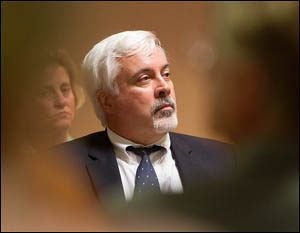ACADEMIC REORGANIZATION
Report to chancellor will consider faculty, staff input
A committee studying cost savings and academic reorganization at East Carolina University plans to offer a recommendation to Chancellor Steve Ballard by April 30.
The decision will incorporate feedback provided by faculty and staff during four forums held April 9-12, said committee chair and geography professor Ron Mitchelson. In those forums, faculty and staff commented on four separate scenarios for reorganization released by the committee in March. Those options pulled components from a menu listing 57 possible changes ranging from the relocation of individual departments to the dismantling and restructuring of entire colleges.
Approximately 65 faculty, staff and administrators offered input during the forums and many more attended. Mitchelson said he appreciates the level of attention the campus is paying this process.
“These sessions have just been invaluable to us,” Mitchelson said. “This is a very, very difficult decision.”
One scenario suggests requiring all academic units to cut administrative budgets – combining for $1 million in annual savings – but enacts no structural changes. A second moves individual departments and programs but leaves existing colleges intact.
The third scenario proposes breaking up the College of Human Ecology or the College of Health and Human Performance, or creating a STEM college centering on science, technology, engineering and math. The remaining units in the Harriot College of Arts and Sciences would be grouped in a new college of social and behavioral science and humanities. A fourth scenario would dismantle two or more of those colleges.
Estimated cost savings associated with those changes range from $1 million to $3.8 million annually, according to a committee report.

ECU vice chancellor for administration and finance Rick Niswander listens to debate about proposed scenarios at the April 12 forum.
Recommending one scenario or a hybrid of those options will end the second phase of the committee’s work. Formed in May 2011, the 13-member group was tasked with reducing costs in the face of continuing fiscal challenges. ECU took a 16.1 percent budget cut in state funding for the 2011-2012 fiscal year following four consecutive years of state budget cuts.
The committee first assessed individual programs and identified areas for investment, maintenance, reduction or elimination. Mitchelson compares those programs to building blocks, and said the scenarios determine how they might best fit together.
In the forums, feedback from faculty and staff focused primarily on a desire to keep existing colleges intact and questioned the details of proposed changes. Many of those who spoke also talked about the impact of pending reorganization on individuals and on the morale in the departments targeted for change.
Jessica Spruill, a staffer in the dean’s office at the College of Human Ecology, asked that the university act quickly and decisively in this process.
“It just doesn’t seem fair,” she said. “We’re all back here just wondering (what will happen). Please don’t drag it out. Just tell us.”
Spruill was one of a dozen staff members who rose during the April 12 forum to show committee members that they are looking for work outside of ECU. Ginger Woodard, associate dean in the College of Human Ecology, said at another forum that anxiety isn’t limited to staff.
“We have people looking at other jobs…because of a fear of what you’re going to do with them right here,” she said. “Please, please consider desperately what we are doing in these scenarios.”
A scenario to create a STEM college focused on science, technology, engineering and math drew vocal opposition April 9 from the Harriot College of Arts and Sciences. Several faculty members said a reorganization splitting their programs between STEM and a new college of social and behavioral sciences and humanities would undermine liberal arts education at ECU. Others argued a split would undermine interdisciplinary work instead of encouraging it.
“I think it’s a myth that you have to be in the same college to collaborate with somebody,” said Mark Sprague, assistant chair for undergraduate studies in physics.
Several in the audience asked why the supporters of a STEM college did not attend or speak at the meeting. Only one faculty member – a physics professor – spoke in favor of a STEM college.
“The majority are against it,” Mitchelson replied. “It’s not a welcome change. However, there are also some pretty strong voices out there that think a STEM college might not be such a bad idea.”
“I fail to see how combining two colleges into two colleges produces cost savings,” said Marieke Van Willigen, director of women’s studies and interim chair of the Department of Sociology.
For more information about the process or to view reports produced by the PPC, visit www.ecu.edu/ppc.

Merchandising and Interior Design professor Dr. Ginger Woodard, right, speaks at the forum regarding the potential reorganization scenarios.